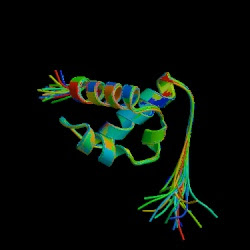 In the short arm of chromosome 4 (4p) too, there are such quizzical repeats. It contains enigmatic repeats of trinucleotide CAG (cytosine adenine guanine). These repeats are highly conserved, again it is not known why. Normally there are 11 to 34 of such trinucleotide repeats. It is known that codons usually give rise to amino acids through transcription and then translation. CAG sequence produce glutamine. Thus the result of these repeats is a polyglutamate residue. The product of this gene is a protein called huntingtin (Htt), a picture of which is shown on the left.
In the short arm of chromosome 4 (4p) too, there are such quizzical repeats. It contains enigmatic repeats of trinucleotide CAG (cytosine adenine guanine). These repeats are highly conserved, again it is not known why. Normally there are 11 to 34 of such trinucleotide repeats. It is known that codons usually give rise to amino acids through transcription and then translation. CAG sequence produce glutamine. Thus the result of these repeats is a polyglutamate residue. The product of this gene is a protein called huntingtin (Htt), a picture of which is shown on the left.In Huntington’s disease, the number of such repeats increases from 37 to 86. The more the repeats, the more the severity of the disease and the earlier the onset. Huntington’s chorea is characterized by hyperkinetic features consisting of rapid, semipurposeful, involuntary, repetitive, unpatterned movements of parts of the body. In the beginning, one limb is involved which ultimately involves the whole body. It appears ass if the patient is dancing, chorea meaning dance. The sequences at exons of 4p also leads to neurodegenerative changes leading to severe dementia and ultimately death. In the middle to late stage of the disease, the caudate nucleus atrophies.
There is loss of GABAergic neurons emerging from the striatum and this causes excitatory symptoms. What causes the destruction of the neurons is unsettled. Abnormal huntingtin may accumulate within the cell and interfere with its metabolism. Recent studies demonstrate that abnormal huntingtin may translocate into the nucleus where it interferes with transcription regulating proteins. Whatever be the mechanism, the consequence is uniformly fatal.
The treatment is virtually non existent. Atypical antipsychotics like clozapine or quetiapine help to relieve dementia, while haloperidol, a dopamine receptor antagonist is somewhat useful in controlling the motor frenzy. Antioxidants, antiglutamates, antiapoptotic agents like caspase 1 inhibitors, inhibitors of aggregation, intracerebral infusion of neurotrophic factors, fetal striatal tissue transplantation and other avenues for combating this illness is desperately being sought. Its time to help them stop dancing.
Last modified: Oct1, 2008
Reference: John B. Penney, Jean-Paul Vonsattel, Marcy E. Macdonald, James F. Gusella, Richard H. Myers (1997). CAG repeat number governs the development rate of pathology in Huntington's disease
No comments:
Post a Comment